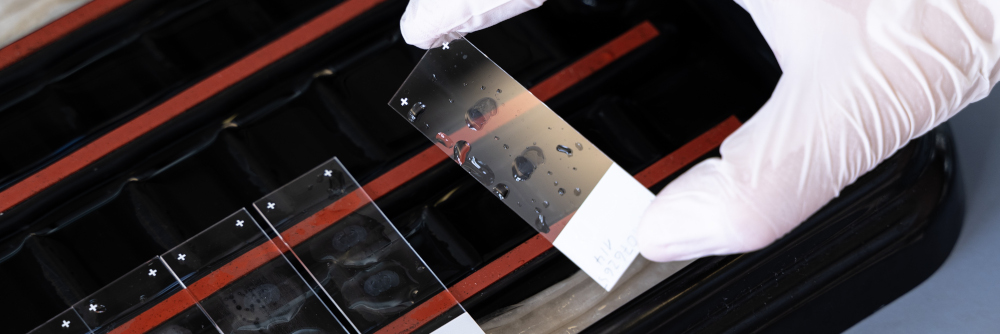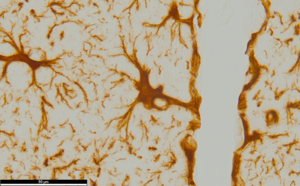AG Kipp
Our interest

The adult vertebrate central nervous system (CNS) mainly consists of neurons, astrocytes, microglia cells and oligodendrocytes. Oligodendrocytes, the myelin-forming cells of the central nervous system (CNS), are subjected to cell stress and subsequent death in a number of metabolic or inflammatory disorders, among which is multiple sclerosis (MS). This disease is associated with the development of large demyelinated plaques, oligodendrocyte destruction and axonal degeneration, paralleled by the activation of astrocytes and microglia as well as the recruitment of peripheral immune cells to the site of tissue injury. Of note, viable oligodendrocytes and an intact myelin sheath are indispensable for neuronal health. For example, it has been shown that oligodendrocytes provide nutritional support to neurons, that fast axonal transport depends on proper oligodendrocyte function, and that mice deficient in mature myelin proteins eventually display severe neurodegeneration.
Our group is interested to understand the physiology and pathology of the axon-oligodendrocyte-myelin unit. Particularly, we are interested to understand to what extend stressed oligodendrocytes regulate peripheral immune cell recruitment, and by which biochemical pathways oligodendrocyte de- and regeneration is regulated. To address our scientific challenges we use state of the art techniques such as design-based stereology, a set of behavioral analyses such as high speed ventral plane videography, or positron emission tomography/computed tomography. Whenever possible, we compare our pre-clinical results with post-mortem samples, obtained from MS patient donors.
Another focus of our group is to characterize astrocytes based on their morphological appearance and link morphological heterogeneities with functional diversity. To this end, we use the sophisticated Neurolucida360-environment to quantify diverse aspects of glia morphology such as ramification, cell area, process distance and others.
Key cooperations
- Clarner, Tim; Anatomy and Cell Biology, Bonn University, Germany
- Schmitz, Christoph; Department of Neuroanatomy, Ludwig-Maximilians-University, München, Germany
- Morrison, Helen; Leibniz Institute on Aging, Fritz Lipmann Institute, Jena, Germany
- Ponsaerts, Peter; Laboratory of Experimental Hematology, University of Antwerp, Belgium
- Luchicchi, Antonio; Anatomy & Neurosciences, VU Amsterdam, The Netherlands
Most important publications
- Translocator protein is a marker of activated microglia in rodent models but not human neurodegenerative diseases. Nutma E, Fancy N, Weinert M, Tsartsalis S, Marzin MC, Muirhead RCJ, Falk I, Breur M, de Bruin J, Hollaus D, Pieterman R, Anink J, Story D, Chandran S, Tang J, Trolese MC, Saito T, Saido TC, Wiltshire KH, Beltran-Lobo P, Phillips A, Antel J, Healy L, Dorion MF, Galloway DA, Benoit RY, Amossé Q, Ceyzériat K, Badina AM, Kövari E, Bendotti C, Aronica E, Radulescu CI, Wong JH, Barron AM, Smith AM, Barnes SJ, Hampton DW, van der Valk P, Jacobson S, Howell OW, Baker D, Kipp M, Kaddatz H, Tournier BB, Millet P, Matthews PM, Moore CS, Amor S, Owen DR. Nat Commun. 2023 Aug 28;14(1):5247
- Siponimod ameliorates metabolic oligodendrocyte injury via the sphingosine-1 phosphate receptor 5. Behrangi N, Heinig L, Frintrop L, Santrau E, Kurth J, Krause B, Atanasova D, Clarner T, Fragoulis A, Joksch M, Rudolf H, Meuth SG, Joost S, Kipp M. Proc Natl Acad Sci U S A. 2022 Oct 4;119(40):e2204509119
- Transmembrane protein 119 is neither a specific nor a reliable marker for microglia. Vankriekelsvenne E, Chrzanowski U, Manzhula K, Greiner T, Wree A, Hawlitschka A, Llovera G, Zhan J, Joost S, Schmitz C, Ponsaerts P, Amor S, Nutma E, Kipp M, Kaddatz H. Glia. 2022 Jun;70(6):1170-1190
- Cuprizone-induced demyelination triggers a CD8-pronounced T cell recruitment. Kaddatz H, Joost S, Nedelcu J, Chrzanowski U, Schmitz C, Gingele S, Gudi V, Stangel M, Zhan J, Santrau E, Greiner T, Frenz J, Müller-Hilke B, Müller M, Amor S, van der Valk P, Kipp M. Glia. 2021 Apr;69(4):925-942
- The cuprizone animal model: new insights into an old story. Kipp M, Clarner T, Dang J, Copray S, Beyer C. Acta Neuropathol. 2009 Dec;118(6):723-36
Current and most recent funding
- DFG Projektförderung (KI 1469/8-1) Titel: Aktivierung der unfolded protein response bei Multiple Sklerose: Funktion im Rahmen der Läsionsentstehung und Progression
- DFG Projektförderung (KI 1469/15-1) Titel: Form und Funktion: Morphologische und molekulare Diversität von Astrozyten in einem entzündlichen Umfeld
- DFG Projektförderung (KE 2509/2-1 | KI 1469/16-1 | WA 5119/2-1) Titel: Alternative Gewebefixierungen in biomedizinischer Forschung, Pathologie und Anatomie
- Hertie-Stiftung - DrPrg WiSe 21Kipp/Manzhula Titel: Anheftungsstelle des Plexus choroideus als Rekrutierungsweg für Immunzellen im MS-Maus-Modell
- Hertie-Stiftung - DrPrg WiSE 22 Kipp/Krüger Titel: Protektive-Eigenschaften von Siponimod bei Multipler Sklerose

